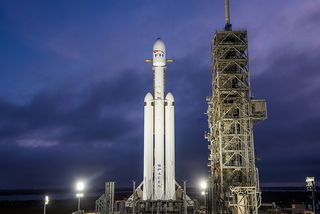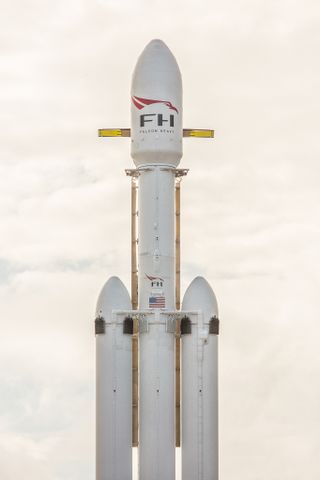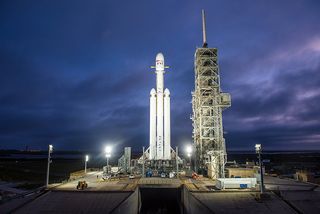If you needed a reminder that SpaceX is about to debut its huge new Falcon Heavy rocket, here you go.
The company just released some gorgeous photos and a spectacular video of the Falcon Heavy standing at Kennedy Space Center's fabled Pad 39A — the one-time jumping-off point for space shuttle and Apollo moon missions — ahead of its planned liftoff later this month. (SpaceX has not announced a target date yet.)
"With more than 5 million pounds of thrust at liftoff — equal to approximately eighteen 747 aircraft at full power — Falcon Heavy will be the most powerful operational rocket in the world by a factor of two," SpaceX representatives wrote on Twitter and Instagram, where they posted the new video. [SpaceX's Falcon Heavy Rocket in Images]
That power comes from a whopping 27 first-stage Merlin engines — three times more than SpaceX's workhorse Falcon 9 rocket has. Indeed, the Falcon Heavy's first stage is essentially three Falcon 9 cores strapped together.

These three boosters are designed to be reusable; after liftoff, they will fly back down to Earth for pinpoint, vertical landings, as they do on most Falcon 9 flights.
Like the Falcon 9, the Heavy is a two-stage rocket. The second stage is powered by a single Merlin, which is identical to the one in the Falcon 9's upper stage.
If all goes according to plan, this month's shakeout cruise will send a red Roadster built by Tesla — the electric-car company Musk runs — into deep space.
Get the Space.com Newsletter
Breaking space news, the latest updates on rocket launches, skywatching events and more!

"Test flights of new rockets usually contain mass simulators in the form of concrete or steel blocks. That seemed extremely boring," Musk wrote in an Instagram post last month. "Of course, anything boring is terrible, especially companies, so we decided to send something unusual, something that made us feel. The payload will be an original Tesla Roadster, playing [David Bowie's] 'Space Oddity,' on a billion-year elliptic Mars orbit."
Of course, there's no guarantee everything will go according to plan. Maiden launches are risky endeavors, and Musk has stressed that we shouldn't be surprised if the first Falcon Heavy dies a fiery death.

"I hope it makes it far enough away from the pad that it does not cause pad damage. I would consider even that a win, to be honest," Musk said at a conference last July. "Major pucker factor, really; that's, like, the only way to describe it."
Follow Mike Wall on Twitter @michaeldwall and Google+. Follow us @Spacedotcom, Facebook or Google+. Originally published on Space.com.
Join our Space Forums to keep talking space on the latest missions, night sky and more! And if you have a news tip, correction or comment, let us know at: community@space.com.

Michael Wall is a Senior Space Writer with Space.com and joined the team in 2010. He primarily covers exoplanets, spaceflight and military space, but has been known to dabble in the space art beat. His book about the search for alien life, "Out There," was published on Nov. 13, 2018. Before becoming a science writer, Michael worked as a herpetologist and wildlife biologist. He has a Ph.D. in evolutionary biology from the University of Sydney, Australia, a bachelor's degree from the University of Arizona, and a graduate certificate in science writing from the University of California, Santa Cruz. To find out what his latest project is, you can follow Michael on Twitter.
